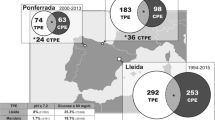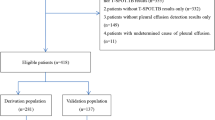Abstract
Background
Patients with pleural effusions who reside in geographic areas with a high prevalence of tuberculosis frequently have similar clinical manifestations of other diseases. The aim of our study was to develop a simple but accurate clinical score for differential diagnosis of tuberculosis pleural effusion (TPE) from non-TB pleural effusion (NTPE).
Methods
This was an unblinded, prospective study of Turkish patients 18 years of age or older with pleural effusion of indeterminate etiology conducted from June 2003 to June 2005. Unconditional logistic regression models were used to discriminate TPE cases from NTPE cases. Standard errors for the area under the curve (AUC) were calculated using the Mann–Whitney method. Data were statistically significance if two-tailed P < 0.05.
Results
A total of 63.3% (157/248) of the patients had TPE while 36.7% (91/248) of the patients had other etiologies for pleural effusions. We were able to provide a predictive model of TPE that included age <47 years and either pleural fluid adenosine deaminase enzyme (PADA) >35 U/l or pleural serum protein ratio >0.710. However, only the combination of age <47 and PADA >35 U/l was significant (odds ratio [OR]: 7.46; 95% confidence interval [CI]: 3.99–13.96). The generated summary score (range = 0–6) was significantly predictive of TPE (OR: 2.91; 95% CI: 2.18–3.89) and with high AUC (0.79).
Conclusion
We propose an affordable model that includes age <47 years and PADA >35 U/l for timely diagnosis of TPE in geographical regions with a high prevalence of TB.


Similar content being viewed by others
Abbreviations
- ADA:
-
Adenosine deaminase enzyme
- AUC:
-
Area under curve
- BCG:
-
Bacillus Calmette-Guérin
- CxR:
-
Chest X-ray
- HRCT:
-
High-resolution chest CT
- LDH:
-
Lactate dehydrogenase enzyme
- MTB:
-
Mycobacterium tuberculosis
- NTPE:
-
Non-TB pleural effusion
- P/SADA:
-
Pleural serum ADA ratios
- P/SLDH:
-
Pleural to serum LDH
- PADA:
-
Pleural fluid ADA
- PE:
-
Pleural effusion
- PLDH:
-
Pleural lactate dehydrogenase enzyme
- PPD:
-
Purified protein derivative
- ROC:
-
Receiver operator curves
- TB:
-
Pulmonary tuberculosis
- TPE:
-
TB pleural effusion
- TST:
-
Tuberculin skin test
- WHO:
-
World Health Organization
References
Light RW (2010) Update on tuberculous pleural effusion. Respirology 15:451–458
Neves DD, Dias RM, Cunha AJ (2007) Predictive model for the diagnosis of tuberculous pleural effusion. Braz J Infect Dis 11:83–88
Berger HW, Mejia E (1973) Tuberculous pleurisy. Chest 63:88–92
Light RW (2007) Pleural diseases, 5th edn. Lippincott, Williams and Wilkins, Baltimore
Poe RH, Israel RH, Utell MJ, Hall WJ, Greenblatt DW, Kallay MC (1984) Sensitivity, specificity, and predictive values of closed pleural biopsy. Arch Intern Med 144(2):325–328
Kirsch CM, Kroe DM, Azzi RL, Jensen WA, Kagawa FT, Wehner JH (1997) The optimal number of pleural biopsy specimens for a diagnosis of tuberculosis pleurisy. Chest 112:702–706
Valdés L, Alvarez D, San José E et al (1998) Tuberculous pleurisy: a study of 254 patients. Arch Intern Med 158:2017–2021
Centers for Disease Control and Prevention (2000) Targeted tuberculin testing and treatment of latent tuberculosis infection. MMWR 49(RR-6):1–71
Giusti G (1974) Adenosine deaminase. In: Bergmeyer HU (ed) Methods of enzymate analysis. Academic Press, New York, pp 1092–1099
Sahn SA (1989) State of the art: the pleura. Am Rev Respir Dis 138:188–234
Abrams LD (1958) New inventions: a pleural biopsy punch. Lancet 1(7010):30–31
Cope C (1958) New pleural biopsy needle. JAMA 167:1107–1108
United Nations Millennium Development Goals Indicators, tuberculosis prevalence rate per 100,000 population (lower bound). http://unstats.un.org/unsd/mdg/SeriesDetail.aspx?srid=791. Accessed 15 July 2011
Valdés L, San José EM, Pose A, Gude F, González-Barcala FJ, Álvarez-Dobaño JM, Sahn SA (2010) Diagnosing tuberculous pleural effusion using clinical data and pleural fluid analysis. A study of patients less than 40 years-old in an area with a high incidence of tuberculosis. Respir Med 104(8):1211–1217
Porcel JM, Vives M (2003) Differentiating tuberculous from malignant pleural effusions: a scoring model. Med Sci Monit 9:CR227–CR232
Light RW (ed) (2001) Pleural diseases, 4th edn. Lippincott, Williams and Wilkins, Philadelphia, pp 108–134
Melo FA, Afiune JB, Santos ML, Castelo Filho A (2000) Diagnóstico da tuberculose pleural pela ADA, isolada ou combinada a outras variáveis, inclusive em HIV-positivos. Folha Med 119(3):9–21
Burgess LJ, Maritz FJ, Roux I, Taljaard JJ (1996) Combined use of pleural adenosine deaminase with lymphocyte/neutrophil ratio. Increased specificity for the diagnosis of tuberculous pleuritis. Chest 109(2):414–419
Kim YC, Pak KO, Bom HS et al (1997) Combining ADA, protein and IFN-gamma best allow a discrimination between tuberculous and malignant pleural effusion [abstract]. Korean J Intern Med 12(2):225–231
Ghanei M, Aslani J, Bahrami H, Adhami H (2004) Simple method for rapid diagnosis of tuberculosis pleuritis: a statistical approach. Asian Cardiovasc Thorac Ann 12(1):23–29
Jones D, Lieb T, Narita M et al (2000) Mesothelial cells in tuberculous pleural effusions of HIV-infected patients. Chest 117:289–291
Levine H, Szanto PB, Cugell DW (1968) Tuberculous pleurisy: an acute illness. Arch Intern Med 122:329–332
Carrion-Valero F, Perpiñá-Tordera M (2001) Screening of tuberculous pleural effusion by discriminate analysis. Int J Tuberc Lung Dis 5:673–679
Sales RK, Vargas FS, Capelozzi VL et al (2009) Predictive models of pleural effusions secondary to tuberculosis or cancer. Respirology 14:1128–1133
Porcel JM, Alemán C, Bielsa S, Sarrapio J, Fernandez de Sevilla T, Esquerda A (2008) A decision tree for differentiating tuberculous from malignant pleural effusion. Respir Med 102:1159–1164
Gupta BK, Bharat V, Bandyopadhyay D (2010) Role of adenosine deaminase estimation in differentiation of tuberculous and non-tuberculous exudative pleural effusions. J Clin Med Res 2(2):79–84
Dheda K, van Zyl-Smit RN, Sechi LA, Badri M, Meldau R, Meldau S et al (2009) Utility of quantitative T-cell responses versus unstimulated interferon-γ for the diagnosis of pleural tuberculosis. Eur Respir J 34:1118–1126
Disclosures
None of the materials in this article has been published elsewhere and has not been submitted simultaneously for publication elsewhere. There was no financial support for this work. The results reported in this article do not constitute official policy from the National Institutes of Health. The authors have no conflicts of interest or an acknowledgment to disclose.
Author information
Authors and Affiliations
Corresponding author
Rights and permissions
About this article
Cite this article
Demirer, E., Miller, A.C., Kunter, E. et al. Predictive Models for Tuberculous Pleural Effusions in a High Tuberculosis Prevalence Region. Lung 190, 239–248 (2012). https://doi.org/10.1007/s00408-011-9342-z
Received:
Accepted:
Published:
Issue Date:
DOI: https://doi.org/10.1007/s00408-011-9342-z




